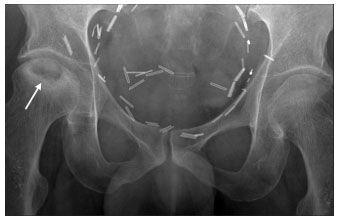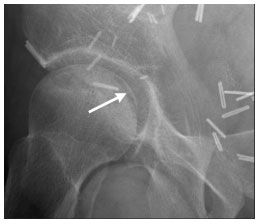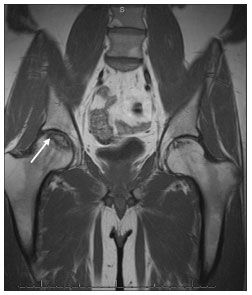- Clinical Technology
- Adult Immunization
- Hepatology
- Pediatric Immunization
- Screening
- Psychiatry
- Allergy
- Women's Health
- Cardiology
- Pediatrics
- Dermatology
- Endocrinology
- Pain Management
- Gastroenterology
- Infectious Disease
- Obesity Medicine
- Rheumatology
- Nephrology
- Neurology
- Pulmonology
HIV-Associated Osteonecrosis of the Hip
A 40-year-old homosexual man with CDC class B3 HIV infection presented to our clinic complaining of worsening right hip pain. HIV infection had been diagnosed in 1995. His most recent CD4+ cell count was 167/µL, and his HIV RNA level was suppressed while he was receiving antiretroviral therapy consisting of emtricitabine/tenofovir fixed-dose combination, efavirenz, and ritonavir-boosted atazanavir.
Key words: HIV/AIDS, Osteonecrosis, Hip
A 40-year-old homosexual man with CDC class B3 HIV infection presented to our clinic complaining of worsening right hip pain. HIV infection had been diagnosed in 1995. His most recent CD4+ cell count was 167/µL, and his HIV RNA level was suppressed while he was receiving antiretroviral therapy consisting of emtricitabine/tenofovir fixed-dose combination, efavirenz, and ritonavir-boosted atazanavir. His other pertinent medical history included chronic hepatitis C; lipodystrophy syndrome; hypertriglyceridemia, with triglyceride levels ranging from 200 to 400 mg/dL; HIV-associated thrombocytopenia requiring prior treatment with glucocorticoids; and bladder cancer (in 2005) that was treated with intravesicular chemotherapy and a radical cystectomy.

Figure 1.Anterior-posterior plain radiograph of the pelvis with subcortical lucency surrounded by sclerosis (arrow) indicating stage III osteonecrosis according to the classification system by Arlet, Ficat, and Hungerford (as reported in Steinberg and colleagues10: stage I, no changes; stage II, cystic and/or sclerotic changes without subcortical lucency; stage III, subcortical lucency and subchondral fracture; stage IV, subchondral collapse; stage V, joint narrowing. Surgical clips reflect previous radical cystectomy in this patient.
He has had mild, intermittent right hip discomfort for the past 6 months. Findings from previous physical examinations were unrevealing, and he retained full mechanical function, initially prompting conservative treatment with anti-inflammatory medication. A heel lift was placed in his right shoe, which offered mild relief. However, his symptoms progressed to a deep, throbbing pain radiating to his right groin, which worsened with weight-bearing activity. Plain radiographs followed by MRI of his pelvis confirmed the diagnosis of osteonecrosis (Figures 1, 2, and 3). He underwent total hip arthroplasty, with complete resolution of his symptoms.

Figure 2. Lateral plain radiograph of the pelvis showing osteonecrosis with the classic "crescent" sign (arrow) of stage III disease. Surgical clips reflect previous radical cystectomy in this patient.
Osteonecrosis, or avascular necrosis, has been described in the HIV literature since 1990.1 The risk of osteonecrosis in HIV-infected persons is almost 100 times the risk in the general population.2 The annual incidence of osteonecrosis among HIV-infected persons ranges from 0.08% to 1.33% compared with 0.01% to 0.135% in the general population.3
The association between HIV infection and osteonecrosis is uncertain.2,4-7 The literature consistently shows an increased risk of osteonecrosis in HIV-infected persons with a history of either corticosteroid use or ethanol abuse.2,3,5 Many other known risk factors exist, including hyperlipidemia, hypercoagulable states, pancreatitis, osteomyelitis, and trauma.3 Several recent studies have failed to demonstrate an independent association between antiretroviral therapy and osteonecrosis, but their results suggest that there may be an increased risk related to adverse effects of the medication, eg, hyperlipidemia and lipodystrophy.2,4-7

Figure 3.MRI of the pelvis with the "double line" sign (arrow) characterized by a high-intensity signal inside a low-intensity peripheral rim indicating osteonecrosis. Note the development of bilateral hip osteonecrosis in this patient.
In our patient, risk factors for osteonecrosis included moderate alcohol use, hyperlipidemia, and previous systemic corticosteroid use. Furthermore, he did not receive an imaging evaluation until 6 months after the onset of his symptoms. What, then, is the optimal way to determine which patients are at high risk and thereby alter modifiable risk factors to prevent joint arthroplasty?
Allison and colleagues3 outlined a diagnostic approach that recommends imaging for any HIV-infected person who has joint pain and 1 or more risk factors for osteonecrosis. Plain radiography, with an overall sensitivity of 40%, is an excellent initial study given its low cost and wide availability. If findings on the radiograph are unremarkable, then MRI, which has a sensitivity of greater than 90%, should be performed. The sensitivity of CT is similar to that of radiography; however, CT is usually reserved for detailing subtle soft tissue changes, which is helpful for staging purposes. Radionuclide bone scintigraphy has intermediate sensitivity yet is valuable for detecting occult disease at other locations.
Treatment is aimed at symptom control and risk reduction. Patients with intermediate disease may benefit from more invasive procedures, such as core decompression, bone grafting, and pulsating electromagnetism; late-stage disease is treated with joint arthroplasty.8 New data also suggest a possible role for bisphosphonates in disease prevention and treatment.9
Although osteonecrosis remains an uncommon disease, it is much more prevalent in the HIV-infected population. Awareness of the risk factors, combined with high suspicion and early imaging, is essential to promptly diagnose osteonecrosis, leading to better symptom control and a decreased need for total joint arthroplasty.
References:
References1. Goorney BP, Lacey H, Thurairajasingam S, Brown JD. Avascular necrosis of the hip in a man with HIV infection. Genitourin Med. 1990;66:451-452.
2. Morse CG, Mican JM, Jones EC, et al. The incidence and natural history of osteonecrosis in HIV-infected adults. Clin Infect Dis. 2007;44:739-748.
3. Allison GT, Bostrom MP, Glesby MJ. Osteonecrosis in HIV disease: epidemiology, etiologies, and clinical management. AIDS. 2003;17:1-9.
4. Ho YC, Shih TT, Lin YH, et al. Osteonecrosis in patients with human immunodeficiency virus type 1 infection in Taiwan. Jpn J Infect Dis. 2007;60:382-386.
5. Brown P, Crane L. Avascular necrosis of bone in patients with human immunodeficiency virus infection: report of 6 cases and review of the literature. Clin Infect Dis. 2001;32:1221-1226.
6. Mary-Krause M, Billaud E, Poizot-Martin I, et al. Risk Factors for osteonecrosis in HIV-infected patients: impact of treatment with combination antiretroviral therapy. AIDS. 2006;20:1627-1635.
7. Gutierrez F, Padilla S, Masiá M, et al. Osteonecrosis in patients infected with HIV: clinical epidemiology and natural history in a large case series from Spain [published correction appears in J Acquir Immune Defic Syndr. 2006;42:650]. J Acquir Immune Defic Syndr. 2006;42:286-292.
8. Cheonis N. Osteonecrosis and HIV disease. BETA. 2002;15:22-29.
9. Lai KA, Shen WJ, Yang CY, et al. The use of alendronate to prevent early collapse of the femoral head in patients with nontraumatic osteonecrosis. A randomized clinical study. J Bone Joint Surg Am. 2005;87:2155-2159.
10. Steinberg ME, Brighton CT, Hayken GD, et al. Early results in the treatment of avascular necrosis of the femoral head with electrical stimulation. Orthop Clin North Am. 1984;15:163-175.
